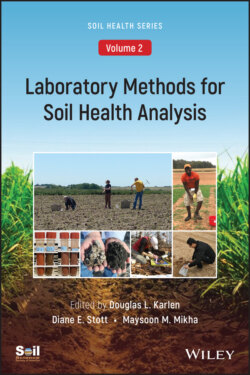Читать книгу Laboratory Methods for Soil Health Analysis, Volume 2 - Группа авторов - Страница 32
Sample Collection, Processing, and Archival
ОглавлениеAfter deciding to implement a soil health assessment, it is important to carefully consider and document every aspect of the experimental design, sampling protocols, and how the samples will be handled. Each set of protocols is inherently project‐specific, underscoring the importance of thorough documentation for future reference. As a guideline for this chapter, protocols adapted from the USDA‐ARS GRACEnet (Greenhouse gas Reduction through Agricultural Carbon Enhancement network) project are listed below (Liebig et al, 2010). Additional guidelines can also be found in Boone et al. (1999) and Dick et al. (1996).
Sampling decisions will vary based on assessment objective(s), geographic location, investigator preferences, and/or agroecosystem attributes. For initial soil health samplings, extra care is warranted since those data will ultimately be referenced as baseline data against which long‐term changes in soil properties are measured. After selecting an appropriate sampling design, the best approach for sample collection in order to meet project goals and soil conditions should be determined and documented in the metadata. For example, mechanical coring devices (handheld or machine‐driven) will often be used because they permit rapid collection of soil samples with a uniform cross‐sectional area. However, for soils with high near‐surface sand content or excessive stones, a compliant cavity method may be a preferable approach (USDA‐NRCS, 2004).
After carefully collecting soil samples, they should be placed in labeled plastic bags, sealed, stored in coolers with ice packs, and transported promptly to a laboratory where they can be held in cold storage (5 °C) until processed. Thick‐gauge polyethylene or double bags may be required to limit moisture loss.
Processing protocols should minimize changes in soil properties. For biological attributes, storage time even at 5 °C should be minimized. If extended storage of biological samples is necessary, freezing at −20 °C is recommended over air‐drying (Sun et al., 2015). For chemical soil health indicators, samples can be air‐dried at 35 °C for 3 to 4 d before sieving to remove rocks, root fragments, and non‐soil material. Some soil physical indicators (e.g. bulk density) should be determined using non‐disturbed samples, while coarse (~8 mm) sieving can be used to prepare samples for aggregate stability analysis (Vol. 2, Chapters 4 and 5).
Though frequently overlooked, archiving of soil samples is critically important, especially for long‐term studies. Archived soil samples provide ‘time capsules’ for assessing temporal changes in soil properties and are particularly valuable as new analytical capabilities are developed (Boone et al., 1999). The amount of soil archived will vary by evaluator goals, available storage space, and projected future needs (e.g. research vs production‐scale monitoring), but in general several hundred grams of air‐dried soil should be archived from ‘time‐zero’ with additional amounts from key subsequent samplings. Archived soil samples should be kept in air‐tight, non‐reactive containers with secure lids and permanent labels. Samples should also be kept in a dry, secure location with moderate temperature conditions and a low probability of water or fire damage.
